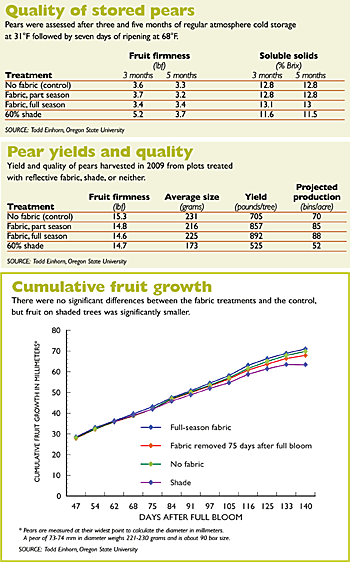Researchers are finding that a reflective mulch in the rows of a mature pear orchard can significantly increase yields by directing more light into the lower canopy.
We are investigating application of Extenday reflective fabric to alleyways of fully mature d’Anjou pear canopies to determine whether or not fabric treatments influence intracanopy light levels, yield, fruit growth rate, final fruit size, and quality.
D’Anjou is the dominant winter pear cultivar produced in the Pacific Northwest, and a large proportion of d’Anjou acreage is aged, planted at low densities, and characterized by large, inefficient canopy architectures. There is little incentive to replant, especially to modern, high-density systems, due to the combination of poor precocity and lack of dwarfing rootstocks. Both scenarios prevent the realization of early net returns, and drive the decision to continue farming suboptimal systems. Further, they underscore a short-term need to identify techniques to improve yields of existing plantings.
A major limiting factor of low-density plantings is the relatively large proportion of the canopy that is either nonproductive (interior, structural wood) or poorly productive (mid portion, low light penetration and distribution). Several physiological processes of pear are sensitive to low light conditions. For example, fruit retention has been suggested to decline strongly with decreasing light levels. Improved bud quality, carbohydrate status, and fruiting strength of many tree fruit crops have all been shown to respond positively to improved light.
 In a replicated trial, Extenday reflective fabric was installed in the spring of 2009 in a mature (more than 50 years old), low-density d’Anjou pear orchard (109 trees per acre), located in the lower Hood River Valley, Oregon. Treatments were:
In a replicated trial, Extenday reflective fabric was installed in the spring of 2009 in a mature (more than 50 years old), low-density d’Anjou pear orchard (109 trees per acre), located in the lower Hood River Valley, Oregon. Treatments were:
- No fabric
- Part-season fabric (applied prior to full bloom and removed 75 days after full bloom, which coincided with the end of June drop)
- Full-season fabric applied prior to full bloom and removed at harvest
- 60% shade cloth applied 60 days after full bloom through harvest (The percentage of shade was based on measured light levels in the interior canopies of control trees, and was not intended as a practical treatment for orchardists, but rather to emphasize the impact of shade on fruit growth processes and yield.)
Results
Weekly d’Anjou fruit growth rate was not affected by either of the fabric treatments (see graph above showing cumulative fruit growth). Growth of shaded fruit ceased two weeks prior to harvest, and these fruit were markedly smaller than fruit of other treatments.
Total tree yields were significantly greater (by about 20%) for fabric treatments relative to the control (see “Pear yields and quality”), even though the control yields were much higher than historic commercial yields for the Hood River district. The two fabric treatments resulted in an additional 15 to 18 bins per acre. Differences in yield between the two fabric treatments were not significant, indicating that higher yields were associated with an increase in fruit number between bloom and 75 days after. Unlike other crops, which benefit from late-season application of fabric to enhance skin color or advance maturity, the major benefit in the present study is early-season influence over fruit set.
Higher yields in the fabric treatments did not coincide with a reduction in average fruit size at harvest (see “Pear yields and quality”). Both fabric treatments peaked on size 90 fruit. (A recent Washington Tree Fruit Research Commission study of reflective fabrics applied to Bartlett pear orchards also observed a significant increase in yield following first-year application. Fruit size was not consistently improved by fabric treatment in that study.)
Higher yields were observed for the fabric treatments in the lower (below 8 feet) exterior, mid, and interior canopy. Photosynthetic active radiation (PAR) was increased under fabric by 25, 90 and 30% in the exterior, mid, and interior zones of the canopy, respectively. Reflected PAR over fabric plots accounted for about 15% of the total light incident on the canopy exterior, compared with only 2% over the grassed alleyways of the control plots. Increased light distribution within pear canopies augmented yields while maintaining the capacity to size fruit to Pacific Northwest industry standards, a phenomenon enabled by the inherently large leaf-to-fruit ratios of such canopies.
Fabric treatments did advance maturity at harvest, though not significantly. Fruit firmness ranged from 0.5 to 0.85 pounds lower for the fabric treatments, depending upon location in the canopy (see “Pear yields and quality”). Interestingly, the smaller, shade-treated fruit softened to levels similar to that of the fabric treatments.
Fruit were placed in regular atmosphere storage (at 31°F) and analyzed at three and five months following a seven-day, 68°F ripening period. Full-season fabric resulted in slightly higher levels of soluble solids. The shade treatment fruit did not develop ripening capacity following three months of storage, as determined by firmness values above four pounds (see “Quality of stored pears”). Shaded fruit also had significantly lower sugar content, as would be expected from the low light levels under the shade structures. Other quality attributes (total acids and extractable juice) were not affected by treatments.
Summary
Reflective fabric applications led to significantly greater yields, without adversely impacting fruit size. Importantly, no significant gains were observed from full-season fabric over fabric removed at 75 days after full bloom. Increased yields were due to improved fruit set, and this was observed in the lower zones of the canopy where light levels were increased under fabric treatment. We are currently in year two of the study, and added a trial in Wenatchee, Washington, in 2010. Both sites will be followed for multiple years.

Leave A Comment